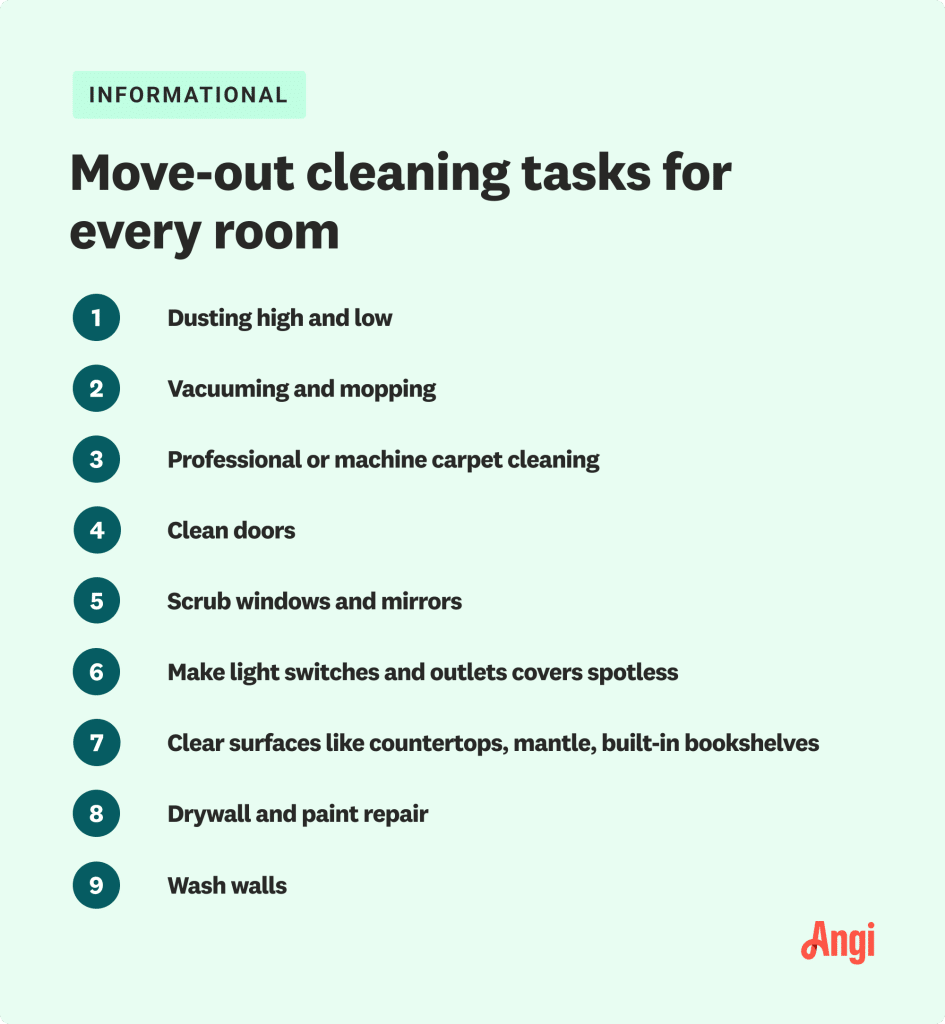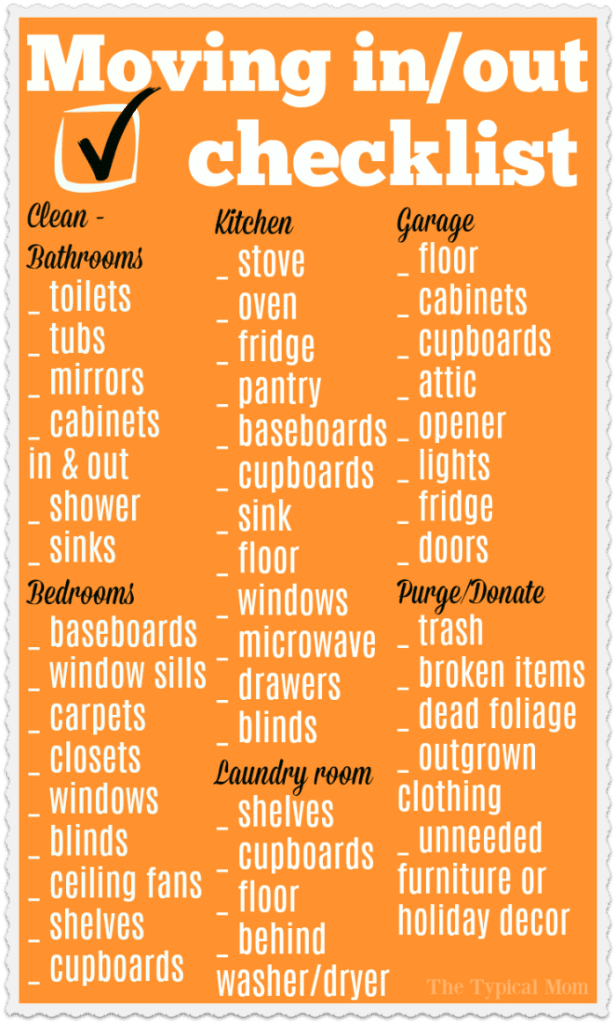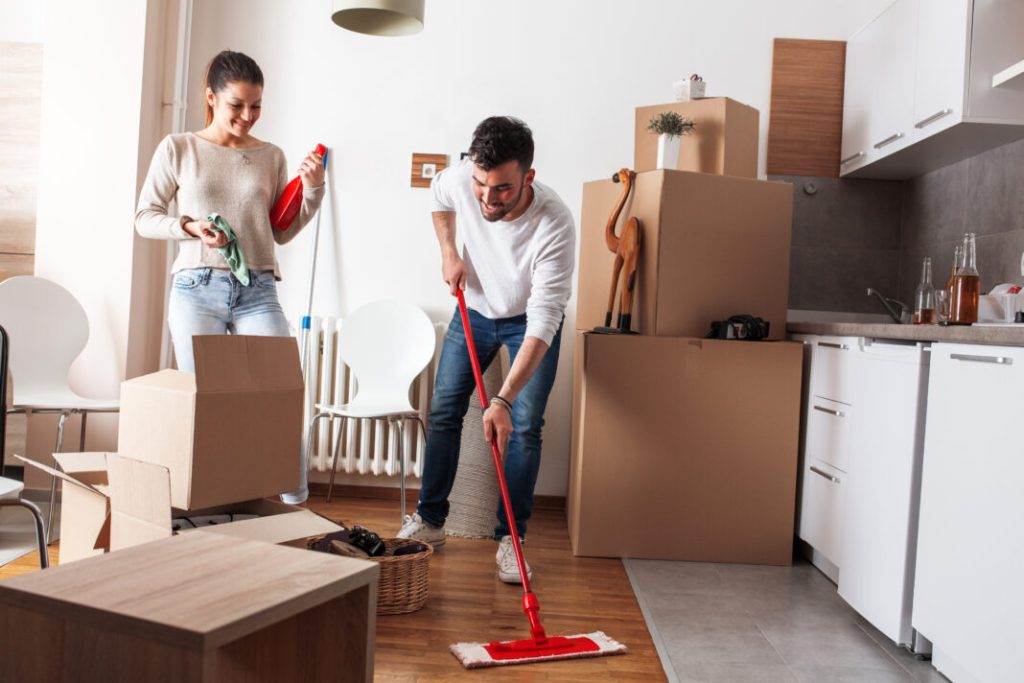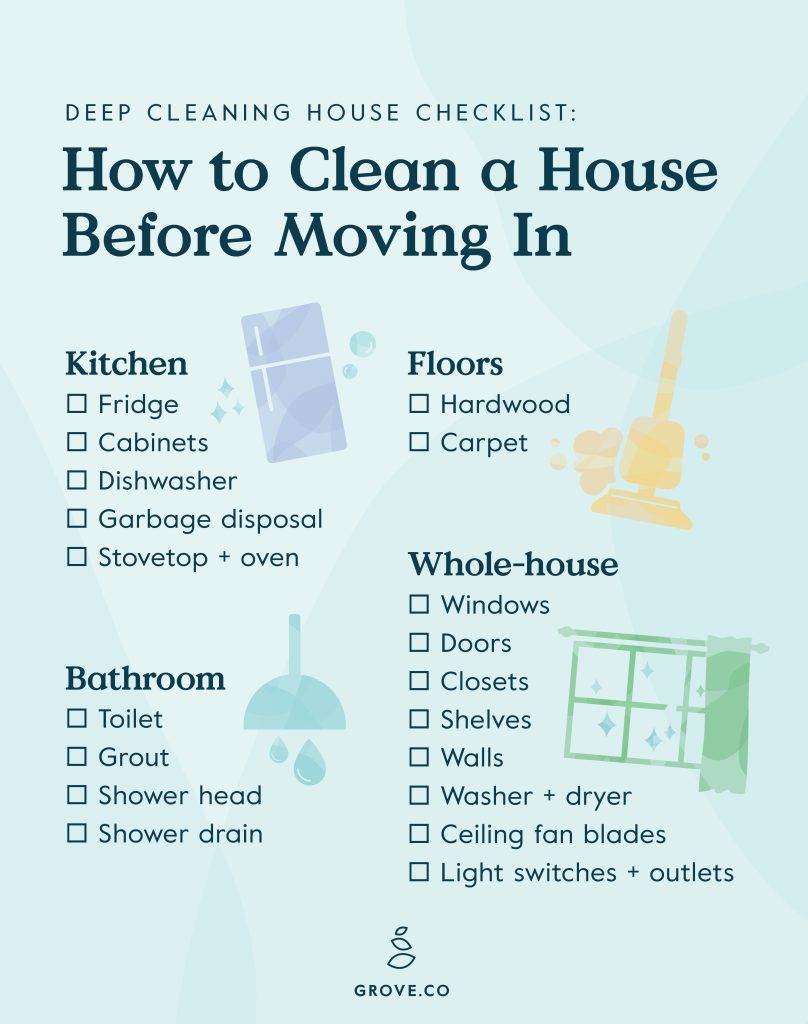30September 2023
Moving out of a house can be both exciting and overwhelming, but one question that often lingers in your mind is, “How clean should your house be when you move out?” As you prepare to bid farewell to your previous abode and embark on a new chapter, ensuring a certain level of cleanliness is vital. This article will provide you with helpful insights on the ideal cleanliness standards when moving out, allowing you to leave your old home in pristine condition.

This image is property of s3media.angieslist.com.
Importance of a clean house when moving out
Moving out of a rented property can be a stressful experience, but one aspect that many tenants overlook is the importance of leaving a clean house. Not only does a clean house meet the expectations of the landlord, but it also increases the chances of getting your full security deposit back. Additionally, leaving a clean and well-maintained space creates a positive impression for the next tenants.
Meeting landlord’s expectations
When you move into a rented property, you usually sign a lease agreement that includes specific cleaning requirements for when you move out. Landlords expect tenants to leave the property in a similar condition to when they first moved in. This means that the cleanliness of the house plays a crucial role in meeting the landlord’s expectations. By thoroughly cleaning the house before moving out, you are showing respect for the landlord’s property and ensuring a smooth transition for the next tenants.
Getting your full security deposit back
One of the primary concerns for tenants when moving out is the return of their security deposit. Landlords often deduct money from the deposit if the property is not left in a clean and well-maintained condition. By taking the time to clean the house thoroughly, you significantly increase your chances of getting your full security deposit back. This extra effort and attention to detail can save you from unnecessary financial losses.
Leaving a good impression for the next tenants
Nobody wants to move into a dirty and unkempt space, and the same applies to the next tenants of your current rental property. By leaving a clean house, you are not only ensuring a smooth transition but also leaving a positive impression on the next occupants. This can lead to positive references and recommendations from the landlord, which can be valuable when you are looking for future rental opportunities. By being considerate and leaving the property in a clean state, you contribute to a more pleasant living experience for the next tenants.

This image is property of temeculablogs.com.
Cleaning checklist for moving out
When preparing to move out, it is essential to have a comprehensive cleaning checklist to ensure that every area of the house is addressed. Breaking down the cleaning tasks into specific areas helps to streamline the cleaning process and ensures that nothing is overlooked. Here is a checklist to guide you through the cleaning process:
General cleaning
- Dust all surfaces, including furniture, shelves, and fixtures.
- Vacuum or sweep the floors and mop hard surfaces.
- Clean all light fixtures and ceiling fans.
- Wipe down doors, door frames, and baseboards.
- Clean all windows and window sills.
Kitchen
- Clean and disinfect all countertops and backsplashes.
- Clean the inside and outside of all kitchen cabinets and drawers.
- Degrease the stove and oven.
- Scrub the sink and clean the faucet.
- Clean the refrigerator and freezer, removing all food and defrosting if necessary.
- Clean the dishwasher and remove any residue or food particles.
- Wipe down all kitchen appliances, such as the microwave and toaster.
Bathroom
- Clean and disinfect the toilet, bathtub, and shower.
- Wipe down all surfaces, including countertops and mirrors.
- Clean the sink and faucet.
- Remove any traces of mold or mildew.
- Sweep and mop the floors.
- Empty and clean all bathroom cabinets and drawers.
Living areas
- Dust all surfaces, including furniture, shelves, and entertainment centers.
- Vacuum or sweep the floors, including under furniture.
- Clean any upholstered furniture using appropriate cleaning methods.
- Clean the inside and outside of the windows.
- Remove any cobwebs from corners and ceilings.
Bedrooms
- Dust all surfaces, including furniture and decor.
- Vacuum or sweep the floors and clean under the bed.
- Wash or change bed linens and pillowcases.
- Clean any mirrors or glass surfaces.
- Empty and clean all closets and storage spaces.
Floors and carpets
- Thoroughly vacuum all carpets to remove dirt and dust.
- Spot clean any stains on the carpets.
- Steam clean the carpets for a more thorough cleaning.
- Sweep and mop hard floors, ensuring all corners are clean.
Windows and blinds
- Clean all windows, inside and out, using glass cleaner.
- Remove any accumulated dirt or dust from blinds using a damp cloth.
- Wipe down window sills to remove any debris.
Walls and ceilings
- Remove any marks or stains on walls by spot cleaning or repainting if necessary.
- Dust and clean any light fixtures or ceiling fans.
- Remove any cobwebs from ceilings or corners using a duster or broom.
Closets and storage spaces
- Empty all closets and storage spaces, and clean shelves, racks, and drawers.
- Remove any dust or debris from the floor of the closets.
- Wipe down the inside and outside of closet doors.
Outdoor areas
- Sweep or hose down front porch, patio, or balcony to remove dirt.
- Clean outdoor furniture and remove any cobwebs.
- Trim any overgrown plants or bushes in the garden.
- Remove any trash or debris from the yard.
Specific areas to focus on
While the overall cleaning checklist provides a comprehensive overview of the tasks required, there are some specific areas that may require extra attention. By focusing on these areas, you can ensure a thorough and efficient cleaning process.
Appliances
Appliances should be given special attention when cleaning before moving out. This includes cleaning the insides of the refrigerator and freezer, scrubbing the stove and oven, and ensuring the dishwasher is free from residue and food particles. A thorough cleaning of these appliances not only improves their functionality but also leaves a favorable impression on the landlord and future tenants.
Cabinets and countertops
The kitchen cabinets and countertops are areas that often collect dirt, grime, and food spills. Take the time to clean both the inside and outside of the cabinets, removing any crumbs or stains. Additionally, wipe down the countertops thoroughly to ensure they are free of any residue or stickiness.
Sink and faucets
The sink and faucets in both the kitchen and bathroom can accumulate grime and mineral deposits over time. Use a suitable cleaning agent or vinegar solution to remove any buildup and give the sink a thorough cleaning. Pay attention to any stains or hard-to-reach areas around the faucets.
Toilet, bathtub, and shower
Cleaning the bathroom fixtures is crucial to ensure a hygienic and pleasant-looking space. Scrub the toilet bowl and remove any stains or mineral deposits. Clean the bathtub, paying attention to any soap scum or grime. Likewise, thoroughly clean the shower walls, floor, and any glass or acrylic surfaces to remove any mold or mildew.
Mirrors and fixtures
Mirrors and light fixtures often accumulate dust and fingerprints. Use a non-abrasive glass cleaner to clean the mirrors and ensure they are free from streaks. Additionally, wipe down any light fixtures to remove any dust or debris that may have accumulated.
Furniture and upholstery
If the property you are moving out of is furnished, it is essential to pay attention to the cleaning of furniture and upholstery. Use appropriate cleaning methods for different types of upholstery, such as fabric or leather. Vacuum any cushions or pillows to remove dust and debris, and spot clean any stains if necessary.
Dust and cobwebs
Dust and cobwebs tend to accumulate in corners, on ceilings, and behind furniture. These areas are often overlooked but should be given attention during the move-out cleaning process. Use a duster or broom to remove any cobwebs, and dust all surfaces thoroughly to ensure a clean and dust-free environment.
Stains and marks
Throughout your tenancy, it is possible that stains or marks may have occurred on walls, floors, or other surfaces. Take the time to assess the condition of these areas and address any stains or marks using appropriate cleaning methods. In some cases, painting or touch-up work may be necessary to restore the surfaces to their original condition.
Trash and debris
Before moving out, it is essential to remove all trash and debris from the property. This includes disposing of any unwanted items, emptying trash cans, and cleaning out any storage areas that may have accumulated excessive clutter. Leaving the property free of any trash or debris increases the convenience for the next tenants and demonstrates your consideration and responsibility.
Gardening and landscaping
If your rental property includes a garden or outdoor space, it is crucial to ensure that it is well-maintained. Trim any overgrown plants or bushes, mow the lawn, and remove any fallen leaves or debris. This extra effort enhances the overall appearance of the property and creates a positive impression for potential tenants.

This image is property of melbournevacateandcarpetcleaning.com.au.
Cleaning methods and products
When it comes to cleaning your house before moving out, it is essential to use the right cleaning methods and products to achieve the best results. Here are some key considerations:
Using eco-friendly cleaning agents
Using eco-friendly cleaning agents is not only beneficial for the environment but also for your health. Opt for cleaning products that are labeled as environmentally friendly, non-toxic, and biodegradable. These products are safe to use around pets, children, and yourself, while still effectively cleaning and sanitizing your house.
Cleaning tools and equipment
Having the right cleaning tools and equipment can significantly improve the efficiency and effectiveness of your cleaning process. Consider investing in a quality vacuum cleaner, mop, broom, and duster. Additionally, have a selection of microfiber cloths and scrub brushes for tackling different surfaces and areas. These tools will help you reach those hard-to-clean spots and achieve a more thorough clean.
Effective stain and odor removal
For tough stains and odors, it is important to use appropriate cleaning agents and techniques. This may include enzymatic cleaners for pet-related stains and odors, specialized stain removers for carpets and upholstery, or bleach for mold and mildew removal. Follow the manufacturer’s instructions and test these solutions on a small area first to ensure they do not cause any damage or discoloration.
Preventing damage to surfaces
While thorough cleaning is essential, it is equally important to avoid causing any damage to surfaces. Use gentle cleaning techniques and avoid using abrasive tools or harsh chemicals on delicate surfaces. For example, use non-abrasive sponges and cleaning solutions specifically designed for glass surfaces to prevent scratches and damage.
Cleaning hard-to-reach areas
During the move-out cleaning process, it is easy to overlook hard-to-reach areas such as vents, ceiling fans, and behind furniture. However, these areas collect dust and dirt over time and can significantly affect the overall cleanliness of the house. Use extendable dusters or vacuum attachments to clean these areas effectively.
Hiring professional cleaners
If you find yourself short on time or unable to complete the move-out cleaning tasks to your satisfaction, consider hiring professional cleaners. Professional cleaners have the expertise and equipment to ensure a thorough clean from top to bottom. They can tackle tough stains, reach difficult areas, and provide a high level of cleanliness that meets and exceeds the expectations of both landlords and new tenants.
Tips for a hassle-free move-out cleaning
Moving out can be a hectic time, but with proper planning and organization, the move-out cleaning process can be much smoother. Here are some tips to help you navigate the cleaning process:
Start early and plan your cleaning schedule
Moving out is often accompanied by a flurry of tasks, so it’s crucial to start early and plan your cleaning schedule in advance. Determine a timeline and allocate specific days or time slots for each area of the house. By spreading out the cleaning tasks over several days or weeks, you can avoid feeling overwhelmed and ensure a more thorough clean.
Gather necessary cleaning supplies in advance
Before you begin cleaning, make sure you have all the necessary cleaning supplies on hand. This includes cleaning agents, tools, microfiber cloths, disposable gloves, and any other specific items required for the cleaning tasks. Having everything ready and easily accessible will help you work more efficiently and avoid unnecessary interruptions.
Delegate tasks to household members or friends
If possible, enlist the help of household members or friends to share the cleaning tasks. Dividing the workload among others not only lightens the burden but also makes the process more enjoyable. Assign specific areas or tasks to each person, and work together to complete the cleaning efficiently. This teamwork can also serve as a bonding experience before parting ways.
Take before and after photos for evidence
Before you begin cleaning, it is a good idea to take some detailed photos of the property. These photos serve as evidence of the initial condition of the house, and can be useful in case of any disputes regarding the condition of the property or deductions from your security deposit. Similarly, take photos after cleaning to document the effort put into restoring the house to a clean state.
Follow specific cleaning instructions from the landlord
Depending on your lease agreement, the landlord may provide specific cleaning instructions or requirements. It is essential to carefully read and understand these instructions to ensure compliance. Following the landlord’s instructions can help you meet their expectations and avoid any potential disputes or deductions from your security deposit.
Don’t forget about exterior and outdoor spaces
While cleaning the interior of the house is crucial, do not forget to pay attention to the exterior and outdoor spaces as well. Sweep or hose down the front porch, patio, or balcony to remove dirt and debris. Clean outdoor furniture and remove any cobwebs. Additionally, ensure that the yard or garden is well-maintained by trimming overgrown plants or bushes and removing any trash or debris.
Final walkthrough inspection with the landlord
Before handing over the keys, schedule a final walkthrough inspection with the landlord. This allows both parties to assess the condition of the property and address any concerns or issues. By conducting this inspection together, you can clarify any expectations or requirements, reducing the chances of misunderstandings or disputes. This walkthrough also provides an opportunity to address any last-minute cleaning tasks if necessary.

This image is property of zumpermedia.s3.amazonaws.com.
Dealing with stubborn stains and damage
During your tenancy, it is possible that accidents or wear and tear may have resulted in stubborn stains or damage to the property. Here are some tips for addressing these issues:
Removing carpet stains
Carpets are prone to stains, especially in high-traffic areas. To remove stubborn carpet stains, start by blotting the stain gently with a clean cloth to absorb as much liquid as possible. Then, apply a carpet stain remover according to the product instructions. Use a clean cloth or brush to work the stain remover into the carpet fibers, and blot the area again to remove any residue.
Repairing wall holes and scratches
Walls can sometimes suffer from nail holes, scratches, or marks. To repair small holes, use spackling compound and a putty knife to fill the hole. Once the compound is dry, sand it lightly to ensure a smooth finish. For larger holes or deep scratches, consider using a wall patch kit or consult a professional for assistance.
Fixing damaged tiles and grout
If you have damaged tiles or grout in the bathroom or kitchen, it is important to address these issues before moving out. Cracked or broken tiles can be replaced individually, while damaged grout can be scraped out and replaced. Take the necessary steps to restore the tiles and grout to their original condition, or consult a professional for more extensive repairs.
Restoring hardwood floors
Hardwood floors are susceptible to scratches, scuffs, or minor damage. To restore the appearance of hardwood floors, start by cleaning the surface thoroughly to remove any dirt or debris. Follow up with an appropriate wood floor cleaner or polish to enhance the shine and minimize the appearance of scratches. For deeper scratches or damage, consult a professional for refinishing or repair options.
Handling pet-related odors and messes
If you have pets, it is essential to address any pet-related odors or messes before moving out. Deep clean carpets and upholstery using enzymatic cleaners specifically formulated to neutralize pet odors. Additionally, clean and disinfect any areas where your pets may have had accidents, ensuring that all odor and stain traces are removed.
Addressing mold and mildew issues
Mold and mildew can pose serious health risks and damage the property. If you notice any signs of mold or mildew during your move-out cleaning, it is crucial to address the issue promptly. Use a mixture of water and bleach or a commercial mold and mildew cleaner to remove the mold from the affected areas. Take necessary precautions such as wearing protective gloves and a mask to avoid exposure.
Professional assistance for major damage
In the case of major damage, extensive stains, or issues that you are unable to address on your own, it may be necessary to seek professional assistance. Professional cleaners, painters, or technicians can provide the expertise and specialized equipment to tackle more significant damage or extensive cleaning tasks. Consider the benefits of professional assistance, especially when it comes to maximizing your chances of getting your full security deposit back.
Legal obligations and tenant agreements
When it comes to moving out and cleaning your rental property, it is important to understand your legal obligations and the terms outlined in your tenant agreement. Here are some key considerations:
Understanding your lease agreement
Before you move out, review your lease agreement to ensure you understand your rights and responsibilities as a tenant. Pay attention to any specific cleaning requirements or expectations outlined in the agreement. Familiarize yourself with any rules regarding the return of the security deposit and any penalties or charges for inadequate cleaning or damage.
Specific cleaning requirements
Lease agreements often include specific cleaning requirements for when you move out. These requirements may vary, but commonly include instructions for cleaning the kitchen, bathroom, floors, and other areas of the property. Take note of any guidelines provided and ensure that your cleaning efforts align with these requirements to avoid any potential disputes.
Consequences of inadequate cleaning
Lease agreements usually outline the consequences of inadequate cleaning or failure to meet the landlord’s expectations when moving out. In some cases, this may result in deductions from your security deposit or additional charges for professional cleaning or repairs. Understanding these consequences can motivate you to carry out a thorough cleaning to avoid any financial losses.
Disputes over security deposit deductions
Disputes over security deposit deductions are common between landlords and tenants during the move-out process. To avoid these disputes, it is important to document the condition of the property before and after cleaning. Take detailed photos and keep a record of any cleaning efforts or repairs made. This evidence can support your case if you need to dispute any deductions from your security deposit.
Legal responsibilities as a tenant
As a tenant, you have legal responsibilities to maintain the property in a reasonably clean and well-maintained condition throughout your tenancy. This includes routine cleaning, reporting any damage or maintenance issues promptly, and following any guidelines or restrictions outlined in the lease agreement. Understanding and fulfilling these legal responsibilities can help you maintain a good relationship with the landlord and ensure a smooth move-out process.

This image is property of images.ctfassets.net.
Alternative options for cleaning
While some tenants prefer to tackle the move-out cleaning themselves, there are alternative options available for those who may not have the time, energy, or expertise to clean the property to a satisfactory standard. Consider the following alternatives:
Hiring professional cleaning services
Professional cleaning services can take the stress out of the move-out cleaning process by handling all the tasks for you. These services have the experience, equipment, and cleaning agents to ensure a thorough clean. By hiring professionals, you can save time and energy, knowing that the property will be cleaned to a high standard.
DIY cleaning vs. hiring cleaners
Deciding between DIY cleaning and hiring professionals depends on various factors, including your time availability, cleaning skills, and personal preferences. While DIY cleaning can save money, it requires more time and effort on your part. On the other hand, hiring professional cleaners provides convenience and expertise. Consider your specific circumstances and choose the option that best suits your needs and budget.
End-of-lease cleaning packages
Many cleaning companies offer end-of-lease cleaning packages specifically tailored for tenants moving out of rental properties. These packages usually include a comprehensive list of cleaning tasks and may be customizable to fit your specific requirements. End-of-lease cleaning packages provide a hassle-free solution and peace of mind, knowing that professionals will handle the cleaning.
Online platforms for finding cleaning professionals
In this digital age, online platforms have made it easier than ever to find and hire cleaning professionals. Websites and apps dedicated to connecting cleaners with clients allow you to view cleaner profiles, read reviews, and compare prices. These platforms provide transparency, making it convenient to find reputable cleaning professionals for your move-out cleaning needs.
Considerations for budget and time constraints
When deciding on the cleaning approach for your move-out, take into account your budget and time constraints. DIY cleaning may be more cost-effective but requires a significant investment of your time and energy. Hiring professional cleaners may be more expensive but saves you time and ensures a thorough, professional clean. Consider your budget, availability, and priorities to make the best choice for your circumstances.
Benefits of leaving a clean house
Leaving a clean house when moving out offers several benefits, both for yourself and the next occupants of the property. Here are some key advantages:
Positive references and recommendations
By leaving a clean house, you are more likely to receive positive references and recommendations from the landlord or property management. This can be valuable for future rental opportunities, as it demonstrates your responsible and considerate nature as a tenant. Positive references enhance your reputation and increase your chances of securing rental properties in the future.
Easier transition for the next occupants
Moving can be a stressful and overwhelming experience, and a clean house can significantly ease the transition for the next occupants. By leaving the property in a clean and well-maintained condition, you provide a welcoming and pleasant environment for the new tenants. Your efforts contribute to a positive moving experience, and the next occupants will appreciate your consideration.
Avoiding disputes and legal issues
A clean house reduces the risk of disputes or legal issues with the landlord. By meeting the landlord’s expectations and complying with the terms of your lease agreement, you minimize the likelihood of deductions from your security deposit or additional charges. This ensures a smoother move-out process and allows you to part ways with the landlord on positive terms.
Maintaining a good reputation as a tenant
Maintaining a good reputation as a tenant is essential for future rental opportunities. Leaving a clean house demonstrates your responsibility and respect for the property and landlord. Landlords or property management companies often share information or references about previous tenants, and a reputation for cleanliness and good maintenance can work in your favor.
Personal sense of accomplishment
Leaving a clean house before moving out gives you a personal sense of accomplishment and pride. It is a satisfying feeling to know that you have taken care of the property, leaving it in a better condition than when you first moved in. The effort and attention to detail that you put into cleaning can create a positive mindset during the transition to your new home.
Conclusion
A thorough move-out cleaning is essential for various reasons. Not only does it meet the expectations of the landlord and increase your chances of getting your full security deposit back, but it also leaves a positive impression for the next tenants. By following a comprehensive cleaning checklist and paying attention to specific areas, you can ensure that every part of the house is clean and well-maintained.
Using the right cleaning methods, products, and equipment further enhances the efficiency and effectiveness of your cleaning efforts. Whether you choose to take on the cleaning yourself or hire professional cleaners, adhering to your legal responsibilities as a tenant and understanding your lease agreement is crucial.
Leaving a clean house benefits you personally, as it contributes to positive references, avoids disputes, and maintains a good reputation as a tenant. Additionally, it eases the transition for the next occupants of the property and provides a sense of accomplishment. By balancing personal effort and professional assistance, you can ensure a smooth and successful move-out process, leaving the property in a clean and welcoming state.
